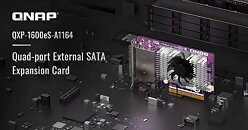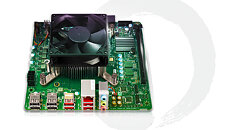
QNAP Unveils TS-h765eU Short-depth Rackmount 4-bay NAS for Space-constrained Environments
QNAP Systems, Inc., a leading computing, and storage solutions innovator, has expanded its diverse portfolio of short-depth NAS products designed for edge storage. The new 1U short-depth rackmount 4-bay 2.5GbE NAS TS-h765eU features a shorter chassis depth and is perfect for small media cabinets and wall-mounted network racks in space-constrained office environments or industrial settings. The TS-h765eU is a long-term supply model till 2031, making it a reliable NAS choice for organizations planning long-term projects or multi-site deployments.
The TS-h765eU combines robust performance, multitasking capabilities, and great I/O expandability to meet diverse application requirements. It features the latest Intel Atom x7000C Series processor, supports built-in 8 GB DDR5 RAM, upgradable to 16 GB (In-Band ECC), has dual 2.5GbE ports, and provides four 3.5-inch SATA drive bays and three E1.S/M.2 PCIe NVMe slots for installing E1.S/M.2 2280 SSDs to enhance read/write performance or upgrading to 10GbE using E1.S interface network modules. Running the ZFS-based QuTS hero operating system, the TS-h765eU prioritizes data integrity, immutability with WORM protection, and powerful data reduction.
The TS-h765eU combines robust performance, multitasking capabilities, and great I/O expandability to meet diverse application requirements. It features the latest Intel Atom x7000C Series processor, supports built-in 8 GB DDR5 RAM, upgradable to 16 GB (In-Band ECC), has dual 2.5GbE ports, and provides four 3.5-inch SATA drive bays and three E1.S/M.2 PCIe NVMe slots for installing E1.S/M.2 2280 SSDs to enhance read/write performance or upgrading to 10GbE using E1.S interface network modules. Running the ZFS-based QuTS hero operating system, the TS-h765eU prioritizes data integrity, immutability with WORM protection, and powerful data reduction.


















































































